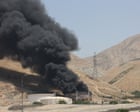The escalatingcrisis between Israel and Iranhas already triggered the largest single-day oil price surge in the last three years, and the question for many is how much higher the oil markets might climb.
The price of Brent crude jumped by about $10 a barrel since the start of June to a high of $78 a barrel on Friday, amid growing concerns thatthe conflictcould wipe out Iran’s oil exports or cut flows of crude from the wider Middle East region to the global market.
For now, oil prices have cooled to below $75 a barrel and remain well below the peak of $115 a barrel after the invasion of Ukraine by Russia, which is one of the world’s biggest oil and gas exporters.
But banks and market forecasters have warned that the trajectory of oil prices will depend on how far the unfolding military and humanitarian crisis betweenIsraeland Iran escalates.
At the upper end, oil prices could spiral to $120 a barrel, according to analysts at Deutsche Bank, surpassing the highs reached in the wake of the Ukraine crisis.
The German investment bank warned that if an escalation were to engulf the wider region, shutting the Strait of Hormuz, then Middle Eastern oil could be blocked from the global market, leading to a price surge.
But this scenario is not the most likely. The bank believes that the oil market may have already accounted for a loss of some Iranian oil production, meaning that prices would most likely remain steady at the current price of about $75 a barrel.
The theory was echoed by analysts at Rystad Energy, a globally recognised consultancy, which said that the conflict appeared likely to be contained by the involvement of the US, which hopes to keep oil prices low.The market would probably remain capped at below $80 a barrel if the White House can broker a period of relative calm in the region, it said.
The market’s muted reaction belies its intense focus on the Strait of Hormuz.
The 21-mile wide waterway located south of Iran is a narrow chokepoint for the world’s fossil fuel supplies, through which 20% of global oil supplies and 20% of liquefied natural gas (LNG) flow.
Iran produced about 3.4m barrels of oil a day in May, and exported about 1.7m barrels a day, or 1.6% of global oil demand.
Fears that the strait could be shut due to regional tensions are well-rehearsed within the global energy industry. Iran has threatened to close the strait in retaliation in the past so although this remains an unlikely scenario it is a key focus for oil market traders.
Lloyd’s List Intelligence, which monitors maritime traffic, said that loadings of vessels in the Gulf continued over the weekend but tankers waiting to load in Iran were keeping a greater distance from the port.The Joint Maritime Information Centre, which coordinates information from international navies, said the strait remained open but the threat to traffic was still significant. It has received reports of electronic interference stemming from the Iranian port of Bandar Abbas on the strait.The United Kingdom Maritime Trade Operations (UKMTO) said on Monday it had received multiple reports of increasing electronic interference in the waters of the Gulf and the Strait of Hormuz.It added that the interference was significantly impacting vessels’ positional reporting through automated systems.
In the UK, the most likely impact of the crisis on household finances would be on petrol prices and gas bills, although this may not be apparent for months.
While the recent oil price hike by $10 a barrel may resultin a 5p increase in petrol and diesel pricesat the pump over the next couple of months, wholesale costs are still well below the highs seen in the first quarter of the year.
Average UK petrol prices have so far remained stable at 132p a litre and diesel at 138.2p a litre, according to the AA, well below the 145.3p a litre and 153.9p a litre for petrol and diesel respectively in March last year.
An escalation of the conflict that blocks UK imports of gas from Qatar, a major UK trading partner, would also have a significant impact on British heating bills. Europe’s gas markets remain well above the levels before Russia’s invasion of Ukraine. But the end of Russia’s pipeline gas exports to most of Europe has left the continent more reliant on imports of gas from farther afield, including LNG imports from the US, the Middle East and Africa.
No. Although flaring geopolitical tensions are frequently used by some to argue for an increase in North Sea oil and gas production there is evidence to suggest that the small volumes produced domestically would do little to temper surging global oil prices.
An oil market surge might mean higher profits for North Sea drillers, but their supplies would be unlikely to mean lower bills for households.
